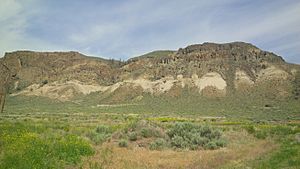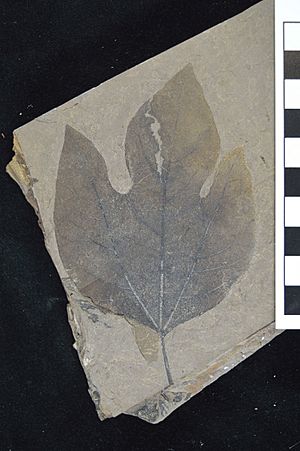McAbee Fossil Beds facts for kids
The McAbee Fossil Beds is a special place in British Columbia, Canada. It's a Heritage Site that protects an ancient lake bed filled with amazing fossils from the Eocene time period. This was about 52 million years ago! You can find the site east of Cache Creek, right near Highway 97 and the Trans-Canada Highway.
The McAbee Fossil Beds cover a large area, about 548 hectares (that's like 1,350 acres). It became a Provincial Heritage Site on July 19, 2012. This site is famous around the world because it has so many different kinds of plant, insect, and fish fossils. Other similar fossil beds from the Eocene period are found in British Columbia at Driftwood Canyon Provincial Park and near Quesnel. There's also a famous one in Washington, USA, called Republic.
The McAbee Fossil Beds reopened to the public on June 21, 2019. Today, the Bonaparte First Nation manages the site.
Contents
Discovering Ancient Life
Scientists have been studying fossils from this area for a long time. The first reports of fossil plants from places like Cache Creek and Kamloops came from G.M. Dawson. More recently, since the 1960s, scientists like Dr. Len Hills and Dr. Mark Wilson have studied the tiny fossil spores, pollen, leaves, and fish fossils found here.
The McAbee Fossil Beds are especially known for their many well-preserved insect and fish fossils. Some of the fish fossils found here include Amyzon, Eohiodon, and Eosalmo. Eohiodon rosei is now thought to be an early relative of today's mooneye fish.
Scientists have learned that the climate around the McAbee Eocene lake was warm and wet. The average temperature was about 11°C (52°F), and winters had no frost. It rained a lot, over 1000 mm (about 40 inches) each year, with rain spread out evenly through the seasons. The amazing detail in the insect fossils, along with the huge variety of insects, plants, and other living things, makes McAbee a special type of fossil site called a Konservat-Lagerstätten. This means it's a place where fossils are incredibly well preserved.
Scientists used special dating methods to figure out the age of the volcanic ash found in the lake beds. They now know that the McAbee Fossil Beds are about 52.9 million years old. This places them in the early Eocene time period.
Ancient Plants (Flora)
The McAbee Fossil Beds are full of plant fossils! You can find leaves, shoots, seeds, flowers, and cones, all very well preserved. Scientists have identified up to 76 different types of plants here.
Some of the cool plant fossils include rare flowers like Dipteronia. This tree is related to maples and today only grows in eastern Asia. There are also extinct members of the birch family, maple seeds (Acer rousei), and fruits and leaves from an ancient beech (Fagus langevinii) and an elm (Ulmus okanaganensis).
The plant fossils show us that the area was once home to a diverse forest. It had trees like cypress, redwood, fir, spruce, pine, and even ginkgo trees. There were also flowering plants like alder, birch, dogwood, beech, sassafras, and grapevines.
Ancient Insects and Other Arthropods
The insect fossils at McAbee are incredibly varied and well preserved. Scientists have found an extinct type of bulldog ant called Macabeemyrma ovata. They've also found green lacewings (Archaeochrysa profracta) and even stick insects. A fossil freshwater crayfish (Aenigmastacus crandalli) was also found here.
The huge variety of insect fossils at McAbee is similar to what you might find in tropical forests today. Recently, scientists even found fossil palm beetles, which confirms that palm trees grew in this area during the early Eocene. This tells us a lot about what the environment was like millions of years ago!
Fossil Collections and Rules
Many fossils from the McAbee Fossil Beds are kept in museums. You can find them at the Royal British Columbia Museum in Victoria, the Royal Tyrrell Museum of Palaeontology in Drumheller, and the Canadian Museum of Nature in Ottawa. Other university collections also have them, like Thompson Rivers University in Kamloops.
For a while, many fossils from McAbee were owned by private collectors and even sold online. But in 2018, a very large private collection of McAbee fossils was given to the Royal British Columbia Museum. This was a big step to help protect these important ancient treasures.
Now, there are clear rules about collecting fossils at the McAbee Fossil Beds. These rules are part of British Columbia's new Fossil Management Framework. This framework helps make sure that fossils are managed properly, protected from damage, and that everyone understands why they are important. It also helps scientists learn more about the fossils found in British Columbia.
Images for kids





